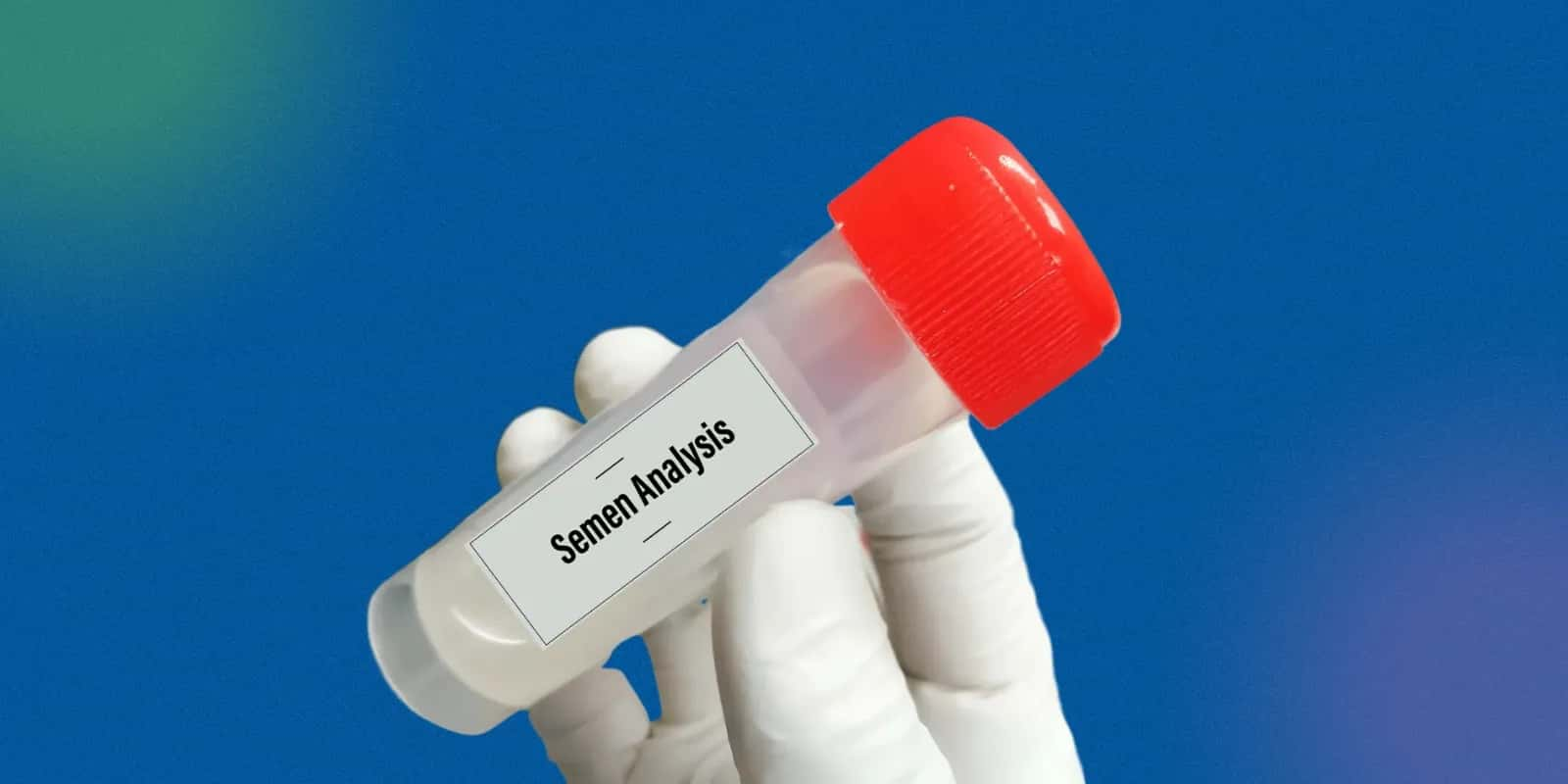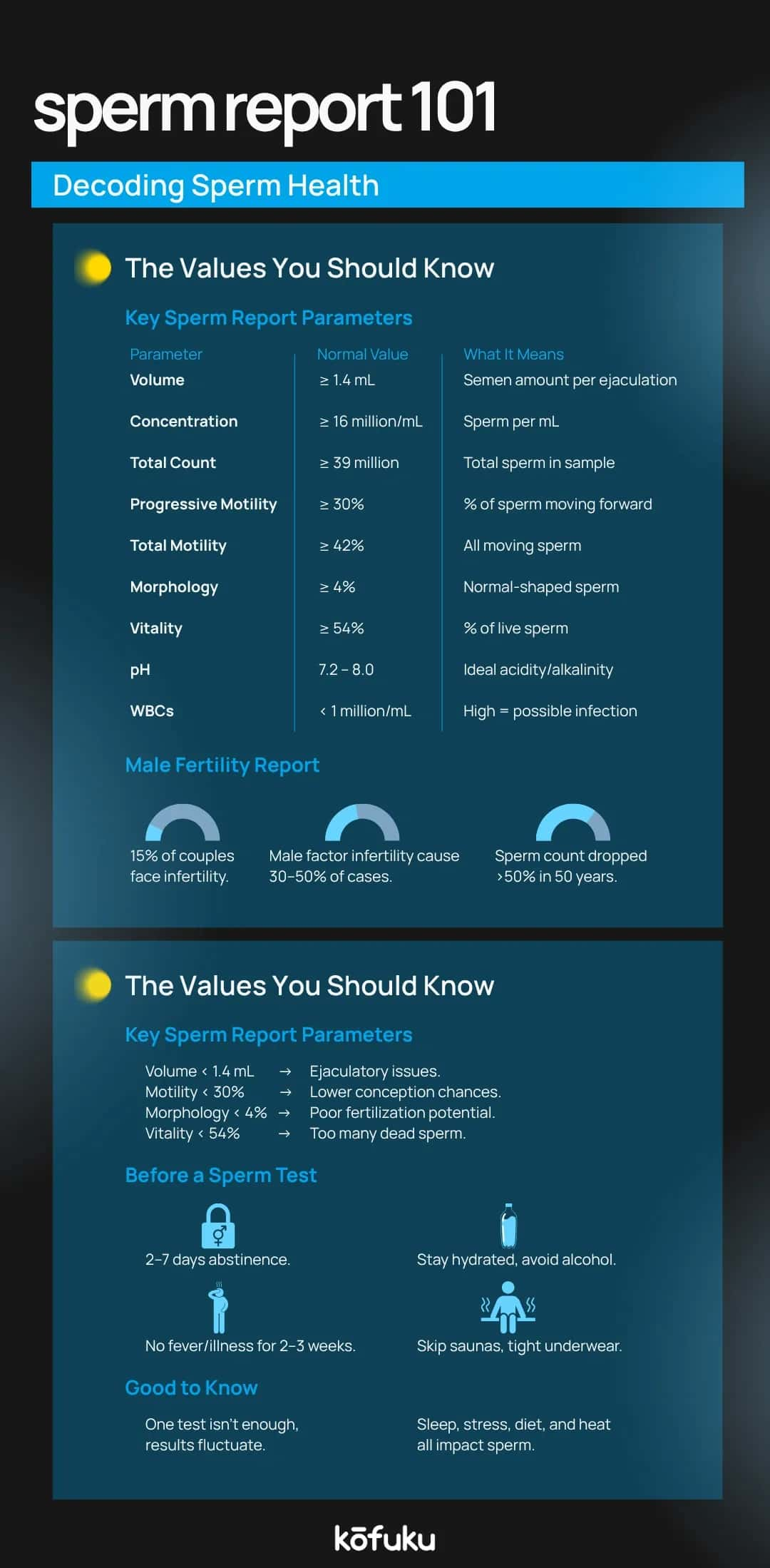How to Read and Understand Your Normal Sperm Analysis Report

Introduction
Almost one out of seven couples is infertile. With such prevalence, it is crucial to understand how and what affects your fertility. Male infertility plays a huge role in up to half of the couples. The fertility of the couple is generally determined by tests.
So, you might have been given a lab report containing some technical medical terms you do not understand, and you need to understand the parameters. Motility, morphology, volume and immotile spermatozoa are the terms most men might find intimidating, but they hold the solution to the health status of male fertility.
In this blog, we will break down how to read a normal sperm analysis report, explain what each value means, explain sperm immobility and suggest ways to improve sperm quality through diet and lifestyle naturally.
What is a Normal Sperm Analysis Report? Key Parameters Explained
The semen or sperm analysis is a test that examines the health and viability of a male's sperm to determine their fertility. The test examines the quantity of the discharged sperm, the morphology and the motility status of the sperm and the possible presence of low sperm count or sperm dysfunction.
Therefore, in case you have just taken a sperm or semen analysis test, then you may be wondering what the words in that report indicate and how you can know whether you are fertile or infertile. Here are some guidelines to help you read the sperm analysis report:
Volume
- Normal Range: 1.5 mL or more per ejaculation
- Significance: Indicates the total fluid carrying sperm. Low volume could suggest issues with the seminal vesicles or the ejaculatory ducts.
Sperm Count
- Normal Range: 15 million sperm per mL or more
- Total sperm count should be at least 39 million per ejaculate.
Sperm Mobility
- Normal sperm motility helps sperm swim toward the egg.
- At least 40% should be motile, and 32% should be progressively motile (i.e., moving forward).
Sperm motility range is usually divided into:
- Progressive motility (PR)
- Non-progressive motility (NP)
- Immotile sperm
Morphology (shape of the sperm)
- Normal sperm morphology: At least 4% of sperm should have a standard shape (head, midpiece, tail).
pH Level
- The pH level of the sperm should range between 7.2 and 8.0.
Liquefaction Time
- Semen should liquefy within 20–30 minutes after ejaculation.

Understanding Sperm Volume, Count, Motility, and Morphology: Normal Ranges and Their Meanings
These parameters are usually presented as numerical values with a reference range in your regular sperm analysis report. This is what to watch out for:

If any values come in below these, it doesn’t qualify you as infertile, but it means you should get further testing or alter your lifestyle.
How to Read Sperm Motility in Your Analysis Report: What is Normal and What is Immotile Sperm?
Sperm motility is sperm movement, which is essential in natural conception. It is separated into:
- Progressive Motility: Sperm move actively forward in a straight line.
- Non-progressive Motility: Sperm move but not effectively forward.
- Immotile Sperm: Sperm do not move at all.
The normal sperm motility is that there should be at least 40 per cent of the sperm motility and at least 32 per cent progressive motility.
What Does Immotile Sperm or Immotile Spermatozoa Mean?
Immotile sperm, also known as non-motile sperm, are sperm cells that are unable to move. If there are more than 60% of immotile sperm, it may affect natural conception and require medical assistance. Sperm immotility may be because of:
- Genetic defects
- Structural problems with the tail
- Infections
- Exposure to toxins or excessive heat
Foods and Lifestyle Changes to Increase Sperm Volume and Improve Sperm Motility
Diet, exercise and the environment have a significant implication when it comes to male fertility. A number of foods that will enhance the volume and motility of sperm are scientifically supported.
Top Foods to Increase Sperm Volume Naturally:
- Pumpkin seeds: Rich in zinc, crucial for sperm production
- Walnuts: High in omega-3 fatty acids
- Spinach and leafy greens: Rich in folate, essential for sperm health
- Citrus fruits: Provide Vitamin C, improving sperm concentration
- Pomegranates: Antioxidants protect sperm from oxidative stress
- Watermelon: Contains L-citrulline, improving blood flow
- Bananas: Loaded with bromelain and Vitamin B6 for hormone regulation
Best Tips to Improve Sperm Motility and Overall Sperm Health
- Avoid smoking and excessive alcohol
- Limit exposure to heat (hot tubs, tight underwear)
- Exercise moderately, avoid extreme workouts
- Maintain a healthy BMI
- Reduce stress through yoga or mindfulness
- Stay hydrated to promote semen fluidity
Home Sperm Analysis Tests: Pros, Cons, and How to Use Them
Sperm analysis home test kits have become increasingly popular, especially for initial screening. However, they have some drawback which you must keep in mind before drawing a conclusion:

Such tests generally concentrate on motility and count of sperm but likely ignore defects in shape, DNA breakage, or signs of infection.
How Reliable Are Sperm Analysis Home Test Kits?
While not a substitute for lab testing, they’re useful for:
- Tracking progress during fertility treatment
- Early screening before medical consultations
- Post-vasectomy confirmation of sperm absence
Still, for a full fertility evaluation, a lab-based test remains the gold standard.

Understanding the Normal Value of Sperm Motility and Motility Range
The normal sperm motility range as per WHO, is:
- Total motility: ≥ 42%
- Progressive motility: ≥ 30%
- Non-progressive motility: ≤ 1%
- Immotile sperm: ≤ 20%
A much lower rate than these ranges should be an indication to evaluate lifestyle or consult a specialist in fertility issues.
Although the concept also exists in bacteria, the concept of motility is also referred to in male fertility. Motility is useful in microbiology in the identification of organisms. It is essential for the functioning of sperm in semen analysis.
Neither of them works without tiny appendages known as flagella located on the tail of that microscopic structure, but in sperm, forward motion is the name of the game of conception.

FAQs
Q. How do I interpret my normal sperm analysis report?
A. A normal sperm analysis includes healthy values for volume (≥1.5 mL), count (≥15 million/mL), motility (≥40%), and morphology (≥4% normal forms). These parameters reflect sperm’s ability to fertilise an egg. Always compare your results to reference ranges and consult a fertility specialist if values fall below normal.
Q. What is the normal sperm motility range?
A. Normal sperm motility includes at least 42% total motile sperm and 32% progressively motile sperm. This indicates the sperm’s ability to swim forward toward the egg. Lower motility can reduce fertility, while immotile sperm (non-moving) may signal structural issues or infections requiring medical attention or lifestyle changes.
Q. What does immotile sperm mean for fertility?
A. Immotile sperm, or immotile spermatozoa, refers to sperm that cannot move. This limits their ability to reach and fertilise the egg, potentially causing infertility. Causes include genetic defects, infections, or poor lifestyle habits. Treatment may involve addressing the cause, assisted reproductive technologies, or lifestyle and dietary improvements.
Q. How can I improve sperm motility naturally?
A. Improve sperm motility by adopting a healthy lifestyle, eating antioxidant-rich foods like citrus fruits and leafy greens, avoiding smoking and alcohol, exercising moderately, and staying hydrated. Zinc, folate, and omega-3 fatty acids are especially beneficial. Reduce stress and prevent heat exposure to the groin to further boost motility.
Q. What foods help increase sperm volume?
A. Foods rich in zinc, antioxidants, and omega-3s, such as pumpkin seeds, walnuts, spinach, bananas, pomegranates, and citrus fruits, help increase sperm volume. Hydration is also essential. These nutrients support hormone balance, semen production, and sperm quality, all of which are vital for improved male fertility.
Q. Are sperm analysis home test kits reliable?
A. Sperm analysis home test kits are useful for initial screening of sperm count and motility. While they offer privacy and convenience, they can’t assess sperm morphology or other fertility indicators. For a complete evaluation, a clinical lab test remains the most accurate and reliable option.
Q. What is considered a normal sperm morphology?
A. Normal sperm morphology refers to the shape and structure of sperm. At least 4% of sperm should have a normal form, proper head, midpiece, and tail. Poor morphology can hinder fertilisation, even if the count and motility are normal. It’s assessed under a microscope during a semen analysis.
Q. How does sperm motility affect male fertility?
A. Sperm motility, the ability of sperm to swim efficiently, is crucial for natural conception. Poor motility reduces the chances of sperm reaching and fertilising the egg. Even with a normal sperm count, low motility can impair fertility, often requiring lifestyle changes, medical intervention, or assisted reproductive techniques like IUI or IVF.
Q. Can lifestyle changes improve sperm count and motility?
A. Yes, healthy lifestyle changes can significantly boost sperm count and motility. A balanced diet, regular exercise, stress reduction, proper sleep, and avoiding smoking, alcohol, and heat exposure support sperm health. Nutrients like zinc, vitamin C, folate, and omega-3 fatty acids play a vital role in improving male fertility.

